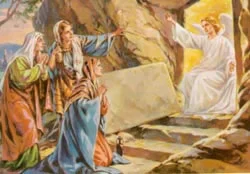Like most Sunday school kids who heard the Passion Narrative read from Mark’s Gospel, I had to ask about the naked guy. Who was he, why was he there, why is he naked? Is this something I’m supposed to be doing as a young Christian: stripping off my clothes at the first sign of trouble and running through the forest? If so, I need to start working out more.
In regards to who this person was, I grew up hearing it was John Mark, the traditional writer of the gospel. No one ever sufficiently explained why in the world he was creeping in the background with no clothes on, or in clothes so ill-fitting that they fell off when he started running. It always seemed very irresponsible. There are some artistic representation of the scene like this one, this one, and this one), which give the plausible, but not recorded in the bible explanation, that one of the arresting soldiers grabbed the young man’s robe to apprehend him, but the young man pulled-a-Joseph, left his clothes, and broke out.
Later in life I was confronted with the symbolic answers ~ the young naked man was:
- A symbol of Jesus’ plight going to the cross
- A symbol of the disciples’ failure
- A symbol of those who have left everything to follow Jesus being left with nothing themselves
Then I came across an interpretation which returned to the physical, sort of.
The young man was an angel.
(What?) [Yeah, that’s what we said.]
The Argument:
The young man in this passage leaves behind his linen garment. The Greek word used here is σινδών. The only other time we see a robe of fine linen show up in Mark is Mark 15:46 referring to the burial shroud of Jesus. In fact, the only other times this specific word (σινδών) is used in the gospels, in the whole New Testament for that matter, is when describing the burial shroud of Christ.
So we’re clear: the only times σινδών appears in the NT, is the clothing the naked young man drops and what Jesus is wrapped in at burial.
In Mark’s resurrection scene (Mark 16:5-7) we encounter “a young man dressed in a white robe” telling the women that Jesus has risen. The other gospels designate this figure as an angel. So "the young man" (angel) has found the σινδών he dropped? Yes and no. This figure is clothed in a different type of robe, with a different Greek name (στολή ) than the shroud mentioned in chapter 14. Which makes sense since he left his in the garden. The other gospels tell us that Jesus’ burial shroud, His σινδών, lies empty in the tomb.
Perhaps the naked young man was an angel. That would explain the “who,” but raises many more questions in terms of the “why.”
Perhaps an angel hanging around in the Garden of Gethsemane specifically to drop the burial shroud for Jesus, which was later picked up by so servant who thought, “this looks pretty,” which somehow came into the possession of Joseph of Arimathea, who said, “this might come in handy,” not knowing he would be wrapping Jesus in it some hours later.
Perhaps.
As with many things biblical, there is no simple answer that pulls all the pieces together nicely and neatly. But whatever message one draws from this passage, one must be drawn: the Bible is not wont to cast random details into the field without expecting germination. And a naked man/angel is not a small detail.
But what do we know: we made this game and you probably think we’re going to Hell.

